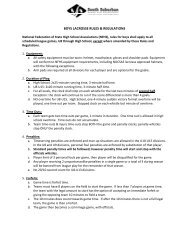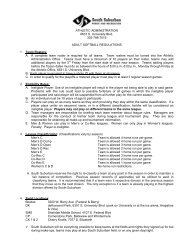2012 Budget - South Suburban Parks and Recreation
2012 Budget - South Suburban Parks and Recreation
2012 Budget - South Suburban Parks and Recreation
You also want an ePaper? Increase the reach of your titles
YUMPU automatically turns print PDFs into web optimized ePapers that Google loves.
<strong>South</strong> <strong>Suburban</strong> Park <strong>and</strong> <strong>Recreation</strong> District<br />
Summary of Significant Financial Policies<br />
Basis of Accounting (continued)<br />
The General Fund, Conservation Trust Fund, <strong>2012</strong> 1 Mill Fund, <strong>and</strong> the Debt Service fund all<br />
have an annually adopted budget.<br />
Proprietary funds distinguish operating revenue <strong>and</strong> expenditures from nonoperating items.<br />
Operating revenue <strong>and</strong> expenditures generally result from providing services <strong>and</strong> goods in<br />
connection with a proprietary fund’s principal ongoing operations. The principal operating<br />
revenues of the District’s enterprise fund are charges to customers for sales <strong>and</strong> services.<br />
Operating expenditures for the enterprise fund include the cost of sales <strong>and</strong> services <strong>and</strong><br />
administrative expense. All revenue <strong>and</strong> expenditures not meeting this definition are<br />
reported as nonoperating revenue <strong>and</strong> expenditures.<br />
For audited financial statement purposes the proprietary fund statements are prepared using<br />
Full Accrual Basis of Accounting. For the full accrual method, revenue is recorded when<br />
earned <strong>and</strong> expenses are recorded when a liability is incurred, regardless of the timing of<br />
related cash flows. For <strong>Budget</strong> purposes the proprietary fund statements are prepared using<br />
Non-GAAP <strong>Budget</strong>ary Basis of Accounting (modified accrual). Several of the differences in<br />
these two methods include the recording of debt service principal payments <strong>and</strong> capital<br />
expenditures. These items are recorded as an expense for the budgetary basis. Depreciation<br />
<strong>and</strong> amortization are not shown for the budgetary basis, as they are non cash items. Other<br />
differences between the two methods can also include how the statements reflect the<br />
proceeds from issuance of debt, contribution of capital assets, gain or loss on sales of assets,<br />
<strong>and</strong> a change in the long term portion of compensated absences.<br />
The District reports the following major proprietary fund:<br />
Enterprise Fund – This fund is used to account for operations that are financed <strong>and</strong><br />
operated in a manner where the intent of the District is that the costs of providing goods<br />
<strong>and</strong> services to the general public on a continuing basis be financed or recovered<br />
primarily through user charges, similar to a business; or where the District has decided<br />
that periodic determination of revenue earned, expenditures incurred <strong>and</strong>/or net income is<br />
appropriate for capital maintenance, public policy, management control, accountability or<br />
other purposes.<br />
The Enterprise Fund has an annually adopted budget.<br />
<strong>Budget</strong>s<br />
In accordance with the State <strong>Budget</strong> Law, the District's Board of Directors holds public hearings<br />
in the fall each year to approve the budget <strong>and</strong> appropriate the funds for the ensuing year. The<br />
appropriation is at the total fund expenditures level <strong>and</strong> lapses at year end. The District can<br />
modify the budget by line item within the total appropriation without notification. The<br />
appropriation can only be modified by Board approval upon completion of notification <strong>and</strong><br />
publication requirements. It is the District’s practice to adopt a balanced budget, in which<br />
planned expenditures are equal to estimated net revenues <strong>and</strong> appropriated fund balances.<br />
57









